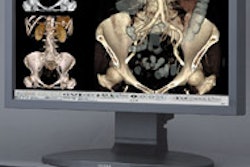SAN ANTONIO - Radiology and information technology departments haven't always been the closest of allies. But PACS can actually bring them together, according to Gene Shaw, vice president of information technology and chief information officer at Yuma Regional Medical Center in Yuma, AZ.
"The partnership (between the IT and radiology) that evolved was totally different than the one that had existed (prior to PACS)," Shaw said.
Shaw spoke on Friday about his experience with implementing PACS at previous employer Centegra Health System at PACS 2005: The Expanding Integrated Digital Healthcare Enterprise, a conference sponsored by the University of Rochester School of Medicine & Dentistry in Rochester, NY.
An integrated delivery network based in McHenry County, IL, Centegra Health System consists of Centegra Northern Illinois Medical Center in McHenry, IL; Sage Cancer Care Center also in McHenry; Centegra Memorial Medical Center in Woodstock, IL; and 25 remote locations in four Illinois and Wisconsin counties. The network performed over 77,000 imaging procedures in its 2004 fiscal year.
For Centegra, the impetus for PACS was a multimillion dollar ambulatory care center expansion, for which digital image management seemed a wiser alternative to putting in dark rooms. Added momentum for buying PACS was gained by the experience of attending the RSNA meeting in Chicago, Shaw said. PACS was also judged to fit Centegra's organizational vision of the clinical quality of a Mayo Clinic and the service quality of a Ritz-Carlton.
A closer relationship
From the PACS implementation process, Centegra has realized that PACS is a marriage between medical imaging and information technology in which divorce is not an option, he said.
The relationship between radiology and IT had historically been characterized by a lack of understanding and distant respect, Shaw said. But that all changed during the PACS initiative.
"We developed a huge amount of understanding between each other," he said.
PACS was implemented at Centegra following an initial one-time $6 million investment over three years. Return on investment was expected to be achieved from film and supplies, by converting dark rooms to revenue-producing space, and by reallocating personnel, Shaw said. Recurring and ongoing costs included infrastructure and the archive.
Clinical stakeholders were enlisted to play an important role in vendor selection, Shaw said. While the IT and radiology departments drove the process, clinical stakeholders defined critical functional requirements for vendors, he said.
Centegra representatives also spent time with several vendors at the RSNA meeting and attended site visits, two for each prospective vendor. After identifying that PACS success was heavily dependent on an adequate infrastructure, Centegra realized that it needed to evaluate its own configuration.
In partnership with the IT department, Centegra expanded infrastructure from its previous topology of a single T1 line to a gigabit metropolitan area network (GigaMAN), which represented the equivalent of 600 T1 lines, Shaw said.
"So we were going from a very small pipe to a huge, huge information highway," he said.
PACS also provided Centegra's IT department an opportunity to get involved in adopting storage area network technology. In other infrastructure planning, Centegra spent some time developing a disaster recovery plan that involved offsite storage, Shaw said.
The move to a filmless environment was driven by the director of medical imaging, director of information systems and CISO, and chief radiologists, he said. This move was focused on improving clinical quality and efficiency, as well as cutting costs.
In addition to necessary infrastructure upgrades, Centegra also encountered other obstacles to PACS, including an evolution of clinical strategy and having to develop a plan to ensure patient privacy, Shaw said.
In the end, however, PACS has yielded clinical quality, online reporting, decreased turnaround time, and remote image retrieval for Centegra, Shaw said. It has also offered benefits such as improved physician relations, added space, the opportunity for IT to delve into new technology, and a new partnership between the IT and radiology departments.
By Erik L. Ridley
AuntMinnie.com staff writer
March 14, 2005
Related Reading
PACS administrator role requires planning, vigilance, March 11, 2005
Web-based workflow and reporting systems keep imaging on track, March 10, 2005
Preparation eases PACS' impact on technologists, March 1, 2005
PACS succeeds clinically, financially for IDNs, February 15, 2005
In-depth approach needed for PACS security, January 20, 2005
Copyright © 2005 AuntMinnie.com



















